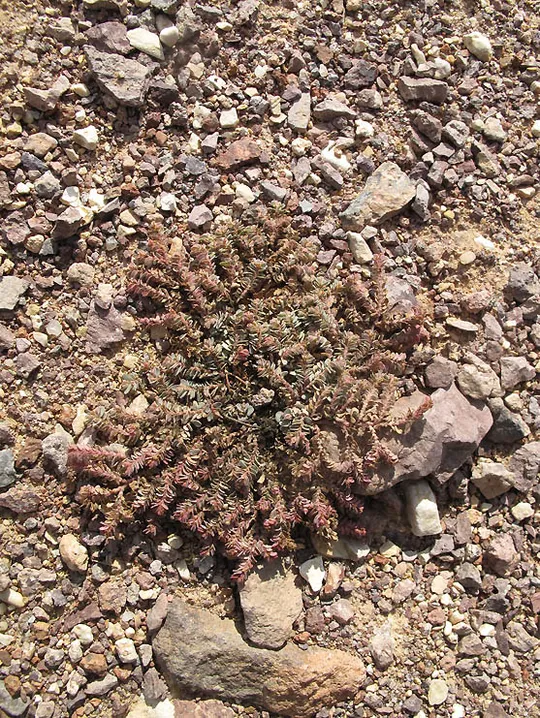Leprous-dotted Spurge
Euphorbia phymatosperma



Euphorbia
phymatosperma is currently known only from two regions
in Israel: the northern Golan Heights from where it was collected in 1992 on Mount
Hozek and from
the Judean Mountains, where it has been collected from several sites since 1925. E. phymatosperma was collected twice in Jerusalem – in 1925 and in the Matsleva Valley in 1945. Since then the plant
has become extinct in the Jerusalem area, and all the efforts made to
find it during the 2001-2002 detailed rare species survey, were unsuccessful. In 2000, the plant was found in gardens at Har Gilo, and in 2004,
it was collected near on the Canub and Ma'on Ridges in the southern
Judean Mountains. On Mount Hermon, the plant is
quite common in the montane zone at
altitudes between 1000 and 1800
meters on rocky slopes in open Prunus domestica and Quercus
libani montane forests. In the Flora Palaestina (Danin, 2004) the species is also recorded
from
Samaria and from
the Philistian Plain and is considered common in the
northern Negev.
Sunny
fallow fields on Samarian and Judean mountains at altitudes above 750 meters.
On the Asfar Ridge, it grows at the edge of an abandoned olive grove, on terra
rossa soil among herbaceous vegetation that includes many components of high transition
zone vegetation.
The genus Euphorbia includes some 2000 species, found
mostly in the tropics but also in the temperate
zone. All the
species of the genus are characterized by their unique inflorescence termed a cyathium (see
above, plant description). Euphorbia is the largest genus of flowering plants in
the world and also has the most diverse morphology and life
forms: annuals, geophytes, cactus-like
succulents and trees. The center of diversity of species and growth forms is in Africa. Groups
of cactus-like Euphorbia
that
grow in the mountains of Equatorial Africa and have giant succulent stems are
particularly unique. Some of the species in this group also grow on the Horn of Africa, in
Yemen, and the Canary Islands. In Israel, forty species grow in all types of habitats.
Twelve species are used for gardening.
All Euphorbia species have a typical bitter, milky sap (possibly carcinogenic). Euphorbia species are known,
mainly because of their milky sap, as medicinal and poisonous plants. This sap is known as a remedy for warts.
• Euphorbia
phymatosperma currently grows on at
least four sites, and two sites in the city of Jerusalem have been destroyed.
•
The
populations in the Judean Mountains are usually sparse, whereas on
Mount Hermon they are abundant.
• The habitat of E.
phymatosperma on the high mountains of Judea and Samaria are severely
threatened by accelerated construction and urban development. Thus, in all Jerusalem there
is only one natural hill (Mar Elias Monastery) whose vegetation remains relatively intact!
Two sites should be immediately assigned for the conservation
of Euphorbia
phymatosperma populations. Their populations should be monitored at
least twice yearly and their seed bank examined.
Euphorbia phymatosperma is
found mainly in the Middle East: it grows
in all the regions of Eastern Turkey – in northeastern
and southeastern Kurdistan; northern Iraq and western
Iran, Lebanon and Syria in the mountains and desert. It is very rare in Jordan in Gil’ad (from
the literature) and relatively common in Edom.
Euphorbia phymatosperma is a
modestly sized annual plant that is of great biogeographic
importance: it represents the arid montane vegetation in the Middle Eastern
mountains, of
which a few "drops" grow on Samarian and
Judean mountain peaks. The species
is both a northern peripheral and very rare in Israel.
The development and urbanization of Israel's central mountain
range destroyed this montane vegetation and
continues to endanger E.
phymatosperma.
Current Occupancy Map
| 1000 squre meter pixel | 5000 squre meter pixel | 10000 squre meter pixel | |
|---|---|---|---|
| number of observations | 0 | 0 | 0 |
| in total pixels | 0 | 0 | 0 |
| Family | Euphorbiaceae |
| Classification | On the extremely rare species list |
| Ecosystem | High Semi – Steppe |
| Chorotype | Western Irano - Turanian |
| Conservation Site | Canub Ridge (Asfar) |
| Rarity |
1
2
6
|
|---|---|
| Vulnerability |
0
1
4
|
| Attractiveness |
0
0
4
|
| Endemism |
0
0
4
|
| Red number |
1
2.1
10
|
| Peripherality | N |
| IUCN category | DD EW EX LC CR EN VU NT |
| Threat Definition according to the red book | Vulnerable |
 Based on:
Based on:





